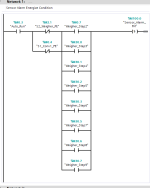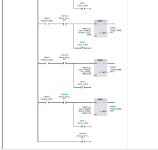thewalkerist
Member
Hello,
As a person who is not that experienced in plcs i am new to a lot of things in this environment. Today my problem includes the alarms, more specifically alarmview. Now to get you guys up to speed i would like to show my alarm conditions and what happens when alarm goes off and how do i deal with the alarm.
Now in screenshot (900).png we see our alarm condition. If S1 and S2 de-energize when we are in any of these steps our Sensor_Alarm_Bit will be set.
In screenshot (901) we can see what happen happens when our Sensor_Alarm_Bit goes off. If we are in any of these steps when our alarm goes off i want my motor to be stopped and my latch to be set(dont focus too much on latch, its trial mechanism that i put up ).
).
In network 3 we see what happens when we acknowledge the alarm (continued in screenshot(902)). It returns the speed value to the value it was before.
Now let say one of our sensors are not seeing and we are in step_6. Sensor_Alarm_Bit will go off and our motor speed wil go to 0. And lets say i fixed the sensor so now its seeing so everything is right again. And i click the acknowledge button in my HMI screen and i will move my specified motor speed in Step_6 to my Motor. And lastly i will reset the Sensor_Alarm_Bit.
Now on to the problem i encountered. I created my Alarm_View and when Sensor_Alarm_Bit energizes my Alarm_View shows me the alarm but there is a problem with acknowledging the alarm. Inside the Alarm_View there is a button for acknowledging, but i cant create an event and set my acknowledge bit with this button.
I know i can create a button myself and use it for both acknowledging and setting my bit at the same time. I already do it in my alarm screen. BUT i cant do this in global screen. I want to be able to acknowledge the problem from my pop-up alarm screen and i cant do it with my alarm_view's button. Maybe i can do it with a comfort panel? Is there a way to get over this problem with a basic panel?



As a person who is not that experienced in plcs i am new to a lot of things in this environment. Today my problem includes the alarms, more specifically alarmview. Now to get you guys up to speed i would like to show my alarm conditions and what happens when alarm goes off and how do i deal with the alarm.
Now in screenshot (900).png we see our alarm condition. If S1 and S2 de-energize when we are in any of these steps our Sensor_Alarm_Bit will be set.
In screenshot (901) we can see what happen happens when our Sensor_Alarm_Bit goes off. If we are in any of these steps when our alarm goes off i want my motor to be stopped and my latch to be set(dont focus too much on latch, its trial mechanism that i put up
In network 3 we see what happens when we acknowledge the alarm (continued in screenshot(902)). It returns the speed value to the value it was before.
Now let say one of our sensors are not seeing and we are in step_6. Sensor_Alarm_Bit will go off and our motor speed wil go to 0. And lets say i fixed the sensor so now its seeing so everything is right again. And i click the acknowledge button in my HMI screen and i will move my specified motor speed in Step_6 to my Motor. And lastly i will reset the Sensor_Alarm_Bit.
Now on to the problem i encountered. I created my Alarm_View and when Sensor_Alarm_Bit energizes my Alarm_View shows me the alarm but there is a problem with acknowledging the alarm. Inside the Alarm_View there is a button for acknowledging, but i cant create an event and set my acknowledge bit with this button.
I know i can create a button myself and use it for both acknowledging and setting my bit at the same time. I already do it in my alarm screen. BUT i cant do this in global screen. I want to be able to acknowledge the problem from my pop-up alarm screen and i cant do it with my alarm_view's button. Maybe i can do it with a comfort panel? Is there a way to get over this problem with a basic panel?







